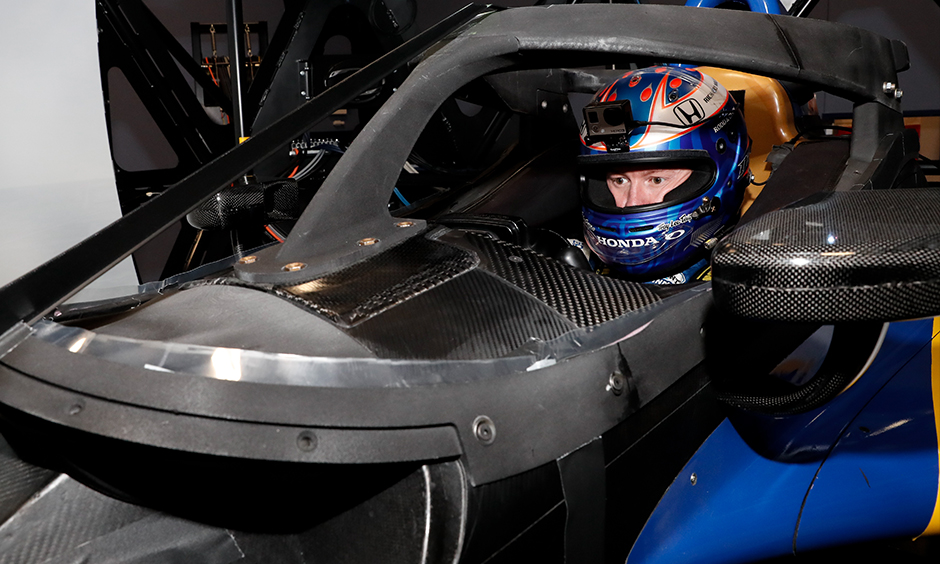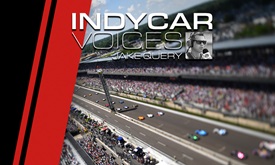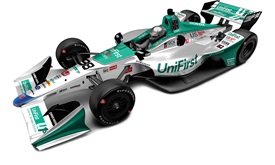Dixon pleased with Aeroscreen simulator test
JUL 02, 2019
Five-time NTT IndyCar Series driver Scott Dixon said Tuesday’s driving simulation of five different racetracks illustrated that INDYCAR is on the right path with its new Aeroscreen, a driver protection device to be implemented for the 2020 season.
The Aeroscreen, developed in partnership with U.K.-based Red Bull Advanced Technologies, consists of a ballistic screen anchored by titanium framework surrounding the driver. The framework mounts in three areas around the cockpit to provide enhanced load-bearing capabilities.
Tuesday’s test at the Dallara Research Center in Speedway, Ind., included Dixon driving simulated laps around five NTT IndyCar Series tracks, including Indianapolis Motor Speedway. The others tracks were Texas Motor Speedway, Iowa Speedway, Barber Motorsports Park and the Long Beach (Calif.) street circuit.
While the polycarbonate laminated screen was not in place for this test, Dixon said he experienced no visibility issues with the framework of the prototype produced by Roush Creative Services. The Chip Ganassi Racing driver said he only noticed the chassis centerline piece, but it was no more of a distraction than the Advanced Frontal Protection device used on Indy cars the past six races (two ovals, two street circuits and two permanent road courses).
“It was very similar to (the AFP),” Dixon said. “So, everything was pretty smooth.”
The simulation included 20 laps on the Indianapolis oval and a half-dozen laps on each of the other tracks. The Aeroscreen mounts in two places in the rear of the cockpit and integrates with the roll hoop for additional reinforcement. Dixon said none of that is in a driver’s line of sight.
In addition to visibility, INDYCAR officials wanted Dixon’s opinion on the change in center of gravity the Aeroscreen creates and the varying loads associated with it. Dixon also got to experience entry and exit from the cockpit, although the he couldn’t put weight on the 3D-printed mock-up produced by Roush.
Dixon has been utilized in two other Aeroscreen tests in this process, the most recent in the same simulator in December. The current Aeroscreen designed by Red Bull Advanced Technologies was announced May 24.
“I think every step of the process has been done very well,” Dixon said. “It’s not throwing things (at the wall) and seeing what sticks; most of it has been proven previously and getting to this portion on the simulator covers a lot of the bases we’ll see when we get to the real world maybe in 30 or 60 days with the first generation (of the Aeroscreen).”
INDYCAR President Jay Frye attended the test along with engineers from the Indianapolis-based sanctioning body, Chip Ganassi Racing and Dallara as well as representatives of Red Bull Advanced Technologies joining remotely.
“The test went just as we thought it would,” Frye said. “No hiccups, no issues.”
The completed Aeroscreen is projected to be track tested for the first time in September at IMS. Included will be an integral heating element and tear-offs, all of which will be produced by integrated third-party companies. Another feature for the drivers will be a cockpit-cooling ducts designed by Dallara in conjunction with Red Bull Advanced Technologies.
Dixon said it has been exciting to be part of INDYCAR’s development process.
“I think the technology game moves very quickly in our sport, and I think INDYCAR has always been at the forefront of moving safety additions along,” he said. “I’m very happy to try and help try to push this forward and be one of the drivers that can help define areas that may be tricky.
“Honestly, it’s been very well done from the get-go and the full process has been well covered in many different areas. So, it’s been pretty easy.”
The NTT IndyCar Series returns to action July 12-14 with the Honda Indy Toronto. The 85-lap race on Sunday, July 14 will air at 3 p.m. ET on NBCSN and the Advance Auto Parts Radio Network.
Seven races remain in the 2019 season, culminating with the Firestone Grand Prix of Monterey on Sept. 22 at WeatherTech Raceway Laguna Seca.




















